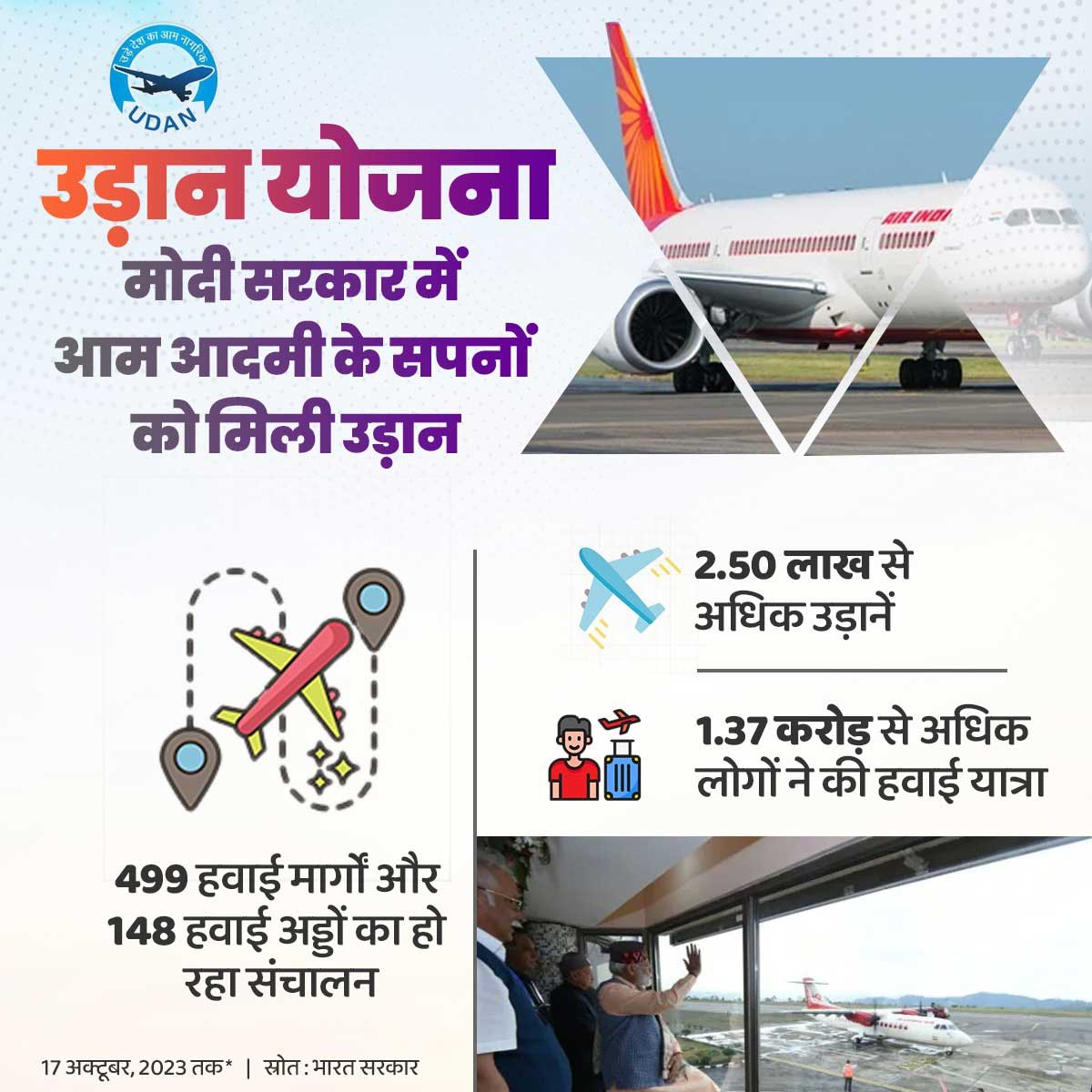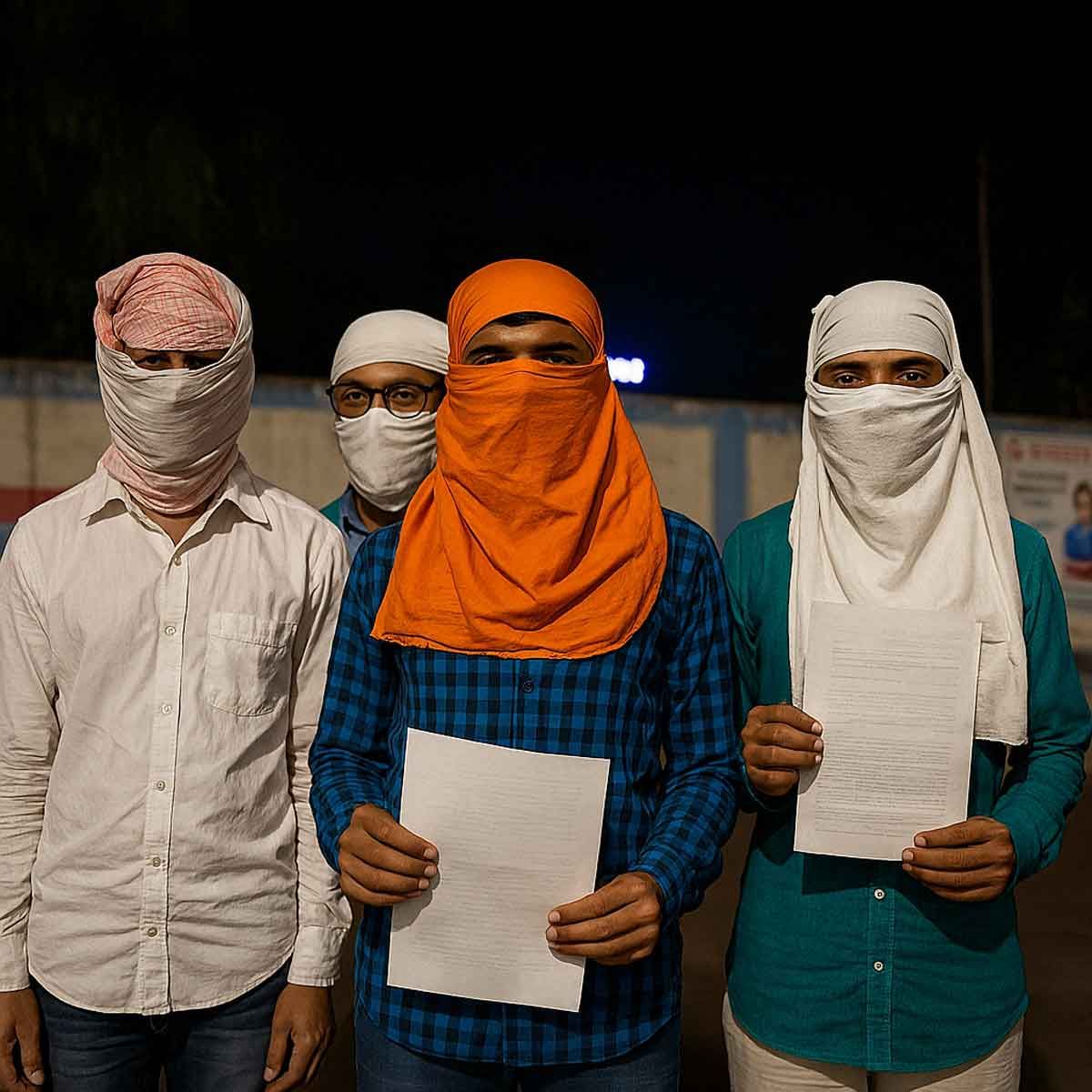More Coverage
Twitter Coverage
Satyaagrah
Written on
Satyaagrah
Written on
Satyaagrah
Written on
Satyaagrah
Written on
Satyaagrah
Written on
JOIN SATYAAGRAH SOCIAL MEDIA
"हवाई चप्पल से हवाई जहाज का सफर": In 6 years, Modi's UDAN bridges 1.3 crore dreams across 499 routes, turning aspirations to altitude, a narrative of unparalleled connectivity, where the sky isn't just a limit, but a new dawn for India's soaring ambition

In a significant milestone, the Modi government's Regional Connectivity Scheme (RCS) – UDAN (Ude Desh Ka Aam Nagrik) – marks its sixth successful year. Launched with the aim of bolstering air connectivity, especially in India's remote and underserved regions, this initiative has since carried an impressive 1.3 crore passengers across 499 routes.
|
The UDAN initiative stands as a core pillar of India's National Civil Aviation Policy (NCAP) 2016. Initiated by the Ministry of Civil Aviation (MoCA) on October 21, 2016, the scheme was rolled out with a forward-looking 10-year vision, underscoring the nation's commitment to strengthening its aviation infrastructure.
One of the many highlights of the RCS-UDAN initiative was the inauguration of its very first flight by Prime Minister Narendra Modi. Taking off on April 27, 2017, this flight bridged the distance between Shimla and Delhi. The Ministry of Civil Aviation elucidates that the scheme's primary focus lies in enhancing air travel in underserved parts of the nation, ensuring that even the common citizen's dreams of flying become a reality.
The sheer number of travelers – more than 130 lakh – benefiting from RCS-UDAN stands testimony to its undeniable success in expanding the reach of air travel across the Indian subcontinent. With each passing year, this initiative reaffirms its commitment to making air travel accessible to everyone.
|
The Evolution of UDAN – From 1.0 to 5.0
Over its six-year journey, the UDAN initiative has witnessed tremendous growth and diversification, adapting to India's vast geographical and cultural landscape. Let's delve deeper into the various versions of the scheme that were rolled out:
UDAN 1.0: The inaugural phase saw the participation of five airline companies, which were awarded 128 flight routes leading to 70 airports. Notably, 36 of these airports were made operational for the very first time, showcasing the rapid strides the initiative took right from its outset.
UDAN 2.0: Building on its initial success, this phase introduced 73 previously underserved or unserved airports to the country's air connectivity map. In an innovative move, helipads were brought into the fold, marking a significant expansion in the types of locations catered to.
UDAN 3.0: This version was characterized by collaboration. Working hand in hand with the Ministry of Tourism, tourism-centric routes became a part of the initiative. Additionally, water aerodromes were connected through seaplanes, and the North-East Region witnessed a surge in routes covered under the scheme.
UDAN 4.0: Emphasizing the topographical challenges of India, this phase gave special attention to North-Eastern Regions, Hilly States, and Islands. Helicopters and seaplanes played a pivotal role in this phase, expanding the reach of the scheme to areas previously considered difficult to connect via conventional aircraft.
Post these four groundbreaking phases, the Ministry of Civil Aviation showcased its commitment to continuous improvement by unveiling the 5th version of RCS-UDAN. This latest iteration incorporated numerous enhancements based on the invaluable feedback of stakeholders, signifying the government's dedication to refining and expanding the program based on the evolving needs of its citizens.
UDAN 5.0: This phase brings a renewed focus on aircrafts from both Category-2 (20-80 seats) and Category-3 (>80 seats). One of the noteworthy changes introduced is the removal of the 600 km cap, meaning there is now no restriction concerning the distance between the flight's starting point and its destination. Such a move showcases a commitment to increasing the flexibility and range of the scheme.
Furthermore, UDAN 5.0 prioritizes routes connecting to airports that are either already operational or soon to be. This strategic decision is aimed at ensuring the swift implementation of the awarded routes. For airlines, this translates to a significant operational advantage: they are now mandated to start their services within just 4 months of a route being awarded. This change is receiving applause from airline companies, as it aids in more efficient planning.
Another game-changing introduction in this phase pertains to route exclusivity. If, for four consecutive quarters, the average quarterly Passenger Load Factor (PLF) of a route surpasses 85%, the exclusivity of that route will be lifted. This adjustment encourages competition, permitting multiple airlines to operate on a single high-demand route, thereby benefiting travelers.
UDAN 5.1: Riding on the success of the previous versions, UDAN 5.1 narrows its focus primarily on helicopter routes. This dedicated round aims to enhance the operational scope for helicopter operators. With an eye on making helicopter travel more financially viable, there is an increase in the Viability Gap Funding (VGF) and a concurrent reduction in Airfare Caps.
The continual evolution of the UDAN initiative, as seen through the lens of its multiple versions, signifies an unwavering commitment to improving air connectivity across India. Each phase, carefully crafted and strategically planned, propels the nation closer to its goal of making air travel accessible and affordable to all.
|
Broadening Horizons – The Latest in UDAN's Endeavor
The UDAN scheme, a beacon of innovation and progress in India's aviation sector, continues its quest to broaden the horizons of air connectivity. With each version of UDAN, there's a clear intent to refine, adapt, and enhance.
Now, the scheme extends its operations, making it mandatory for routes to have at least one origin or destination in a priority area and at least one origin or destination as a heliport. This move is aimed at further widening the scope of connectivity, especially in regions that were previously thought to be inaccessible.
To ensure the commercial viability of the scheme for operators and the affordability factor for passengers, the Viability Gap Funding (VGF) has been increased. Simultaneously, airfare caps have seen a downward revision, paving the way for more affordable air travel for the Indian populace.
As we speak, UDAN 5.2 is in its bidding phase. This version sets its sights on even more remote and regional parts of the nation. The emphasis is on attaining that elusive last-mile connectivity and providing a shot in the arm for the tourism sector. Specifically, this phase is tailored for small aircrafts, those with less than 20 seats. The scheme, in its quest to offer operational flexibility, permits these small aircraft operators to function within a range. They can operate up to 40% of the RCS seats they quote annually and have a floor limit of at least 10% in any given quarter, as elaborated by the Ministry.
Reflecting on the larger impact of RCS-UDAN, the Ministry proudly announced its pivotal role in the growth of the civil aviation sector. The last six years have witnessed the emergence of four new, thriving airline companies. RCS-UDAN hasn't just been a platform for enhanced connectivity; it has been a cradle for entrepreneurship in the aviation sector. It has nurtured airline operators, giving them the right tools and environment to not only commence their operations but also to carve a sustainable business niche for themselves.
|
The story of UDAN is not just about flights and routes; it's a tale of growth, innovation, and endless possibilities. With every new chapter, it promises to take India to greater heights, quite literally!
Small regional airlines, which once functioned on the peripheries of India's aviation map, have now found themselves thrust into the limelight, thanks to the UDAN scheme. Names like FlyBig, Star Air, and IndiaOne Air stand out as prime examples. Their meteoric rise and sustained success serve as undeniable proof of the scheme's capability to nurture and provide a thriving environment for the airline business.
Moreover, the phased and strategic expansion of the scheme has set the stage for a burgeoning demand for new aircraft. This isn't just about increasing the number of planes; it's about diversifying the types of aircraft that take to the skies. From helicopters and seaplanes to 3-seat propeller planes and larger jet planes, the growth has been holistic, encompassing a broad swath of the aviation spectrum.
At present, travelers taking advantage of RCS routes are served by a varied and modern fleet. From the likes of the Airbus 320/321, Boeing 737, ATR 42 and 72, DHC Q400 and Twin Otter, to the Embraer 145 and 175 and the Tecnam P2006T, the range of aircraft in operation is both impressive and indicative of the scheme's expansive reach.
India's aviation sector is on the ascent, and this is evident from the robust demand for aircraft that's currently being witnessed. The country's airlines have placed orders for more than 1,000 aircraft, marking a significant leap considering they're expected to be delivered over the coming 10-15 years. For context, India's present fleet is an amalgamation of approximately 700 planes operated by diverse airlines.
However, the brilliance of RCS-UDAN isn't restricted to just the addition of aircraft or providing connectivity. It's much more profound and multi-dimensional. While the scheme's primary drive revolves around bridging gaps in connectivity, especially in tier-2 and tier-3 cities, it also emerges as a potent force in amplifying India's tourism sector.
The integration of the tourism sector into the UDAN scheme was strategically planned. UDAN 3.0 carved paths to several destinations in the Northeast, while UDAN 5.1 honed its focus on enhancing helicopter services in hilly terrains. The ultimate aim? To give a shot in the arm to tourism, hospitality, and local economies.
Several destinations, now more accessible than ever, stand out as beneficiaries of the UDAN initiative. Places like Khajuraho, Deoghar, Amritsar, and Kishangarh (Ajmer), significant for their religious tourism appeal, have witnessed an upswing in footfalls. And then there's the Northeast, a region known for its unparalleled beauty. The unveiling of airports in locations such as Pasighat, Ziro, Hollongi, and Tezu has led to a marked surge in tourist arrivals.
To sum it up, the RCS-UDAN initiative is more than just an aviation scheme. It's a testament to the Indian government's commitment to holistic development, encompassing both connectivity and culture. As we look to the skies, it's heartening to see them crisscrossed with paths that lead to growth, unity, and an unfolding story of a nation on the move.
 |
| UDAN Scheme - Taking flight towards a brighter India! With the mantra of 'Empower the common citizen to take flight,' |
Various Concessions offered on RCS routes Under RCS UDAN Scheme
- Central Government
- Excise Duty at a concessional rate of 2% is levied on ATF purchased by Selected Airline Operators from RCS Airports
- Selected Airline Operators have the freedom to enter into code sharing arrangements with both domestic as well as international airlines.
- Reimbursement of the GST component on airfares of RCS Seats sold in an RCS Flight at actuals from the RCF (for UDAN 1‐3).
- State Governments
- Reduced VAT on Aviation Turbine Fuel (ATF) at RCS Airports located within the state to 1% or less for a period of 10 years;
- Provision of minimum land, if required, free of cost and free from all encumbrances for development of RCS Airports along with provision of multi‐modal hinterland connectivity (road, rail, metro, waterways, etc.) as required;
- Provision of security and fire services free of cost at RCS Airports;
- Provisions of electricity, water and other utility services atsubstantially concessional rates at RCS Airports; and
- States other than North‐Eastern States (NER), and Union Territories (UT) provide 20% of the VGF share determined pursuant to this Scheme, while for NERs and UTs, the contribution is 10%.
- Airport Operators
- No Landing Charges, Parking Charges on RCS Flights;
- No levy of any Terminal Navigation Landing Charges (TNLC) on RCS Flights;
- RNFC levied by AAI on a nominal basis @ 42.50% of Normal Rates for RCS Flights. Normal Rates refer to applicable rates specified by AAI without any discount or concessions;
- Selected Airline Operators allowed self‐ground handling for operations under the Scheme at all airports.
 Support Us
Support Us
Satyagraha was born from the heart of our land, with an undying aim to unveil the true essence of Bharat. It seeks to illuminate the hidden tales of our valiant freedom fighters and the rich chronicles that haven't yet sung their complete melody in the mainstream.
While platforms like NDTV and 'The Wire' effortlessly garner funds under the banner of safeguarding democracy, we at Satyagraha walk a different path. Our strength and resonance come from you. In this journey to weave a stronger Bharat, every little contribution amplifies our voice. Let's come together, contribute as you can, and champion the true spirit of our nation.
 |  |  |
| ICICI Bank of Satyaagrah | Razorpay Bank of Satyaagrah | PayPal Bank of Satyaagrah - For International Payments |
If all above doesn't work, then try the LINK below:
Please share the article on other platforms
DISCLAIMER: The author is solely responsible for the views expressed in this article. The author carries the responsibility for citing and/or licensing of images utilized within the text. The website also frequently uses non-commercial images for representational purposes only in line with the article. We are not responsible for the authenticity of such images. If some images have a copyright issue, we request the person/entity to contact us at This email address is being protected from spambots. You need JavaScript enabled to view it. and we will take the necessary actions to resolve the issue.
Related Articles
- Konark Chakra - Bharat’s Chariot of Progress at G20 Summit echoes our vibrant journey, a harmonious blend of rich heritage and dynamic innovation, steering the nation towards a bright, inclusive future on the global stage, fuelled by cooperation & harmony
- In yet another milestone of BJP, Indian Railways First-Ever Freight Train Reaches ‘Rani Gaidinliu Railway Station’ marking a major breakthrough for railway authorities: Manipur
- "In unity there is strength; in partnership, there's power": India-UAE economic alliance marks turning point in their shared history, CEPA to boost trade, stimulate investments & fortify economies, advancing both nations towards mutual growth & prosperity
- "New dynamism in ties": In Jakarta, PM Modi calls for a new rules-based order in the post-Covid era, emphasizing the critical role of the ASEAN-India partnership in shaping the resurgence of Asia in the 21st century and fostering global growth
- Delhi skies echoed with the sound of roaring engines as @airindia 1139 descended, bringing home 212 Indians from war-torn Israel, chants of 'Vande Matram' & 'Bharat Mata Ki Jai' resonated, celebrating Operation Ajay's triumph for India, that is Bharat
- "A lotus symbolizes purity amidst adversity": Introducing 'Namoh 108', a new variety of special lotus with 108 petals from Lucknow's CSIR-NBRI, it's not just a flower, but a tribute to India's traditions, plus, it blooms longer than other lotuses
- Semiconductor Titans, Micron, Applied Materials, and Lam forging robust alliances with India, unveiling monumental billion-dollar investments to significantly bolster India's Semiconductor Mission and usher a future of unprecedented tech advancements
- "Global trust, local talent: India's invitation to the semiconductor world": PM Modi announces that India's moment has arrived in the semiconductor, Global leaders unite in praise as India gets ready to take center stage in the semiconductor industry
- World’s highest tunnel to be built by BRO to connect Himachal Pradesh and Zanskar valley in Union Territory of Ladakh; will ease movement of the Indian Army vehicles: Director-General of BRO, Lt Gen Rajeev Chaudhary
- "The bridge between reality and a dream is work": Anji Khad Bridge - An Engineering Marvel took 11 months to ready India’s first cable stayed rail bridge with 96 cables set constructed in the Reasi district of the Union territory of Jammu and Kashmir
- "In the market's good mood, fortunes are made and dreams are realized": Indian Tractor Sales soar to Unprecedented Heights by hitting all-time-high record of 9.44 lakh units in FY23, up 12% compared to last year, Brands achieve record-breaking figures
- "Create your own miracles; do what you think you cannot do": BRO's Engineering Marvels - Bridging Gaps, Transforming Lives in challenging terrain through crucial road networks, playing a vital role in national security, and fostering socio-economic growth
- In a monumental stride, India unveils the world's first BS-VI ethanol car, blending technology with agriculture and championing a vision for a sustainable, greener future while bolstering its economy & reinforcing its stand on environmental responsibility
- "Real museums are places where Time is transformed into Space": PM Modi unveils the Mascot of the International Museum Expo 2023 - a contemporized version of the Dancing girl in Chennapatnam art style to celebrate the 47th International Museum Day
- "If art is to have a special train, the critic must keep some seats reserved on it": In a momentous event, PM Narendra Modi flagged off Puri-Howrah Vande Bharat Express in Odisha, marking a significant milestone in India's railway infrastructure evolution




























